Losing a limb changes life in many ways. Whether from an accident, illness, or a medical condition, the journey to finding the right prosthetic is personal and important. Today, people have more options than ever before. Some choose traditional prosthetics, which have been around for centuries, while others opt for advanced bionic limbs with smart technology.
But how do you decide? Which one suits your lifestyle, needs, and budget? In this guide, we’ll explore the differences between bionic and traditional prosthetics, helping you make the best choice for you or a loved one. By the end, you’ll have a clear understanding of what each type offers and how it can improve your daily life.
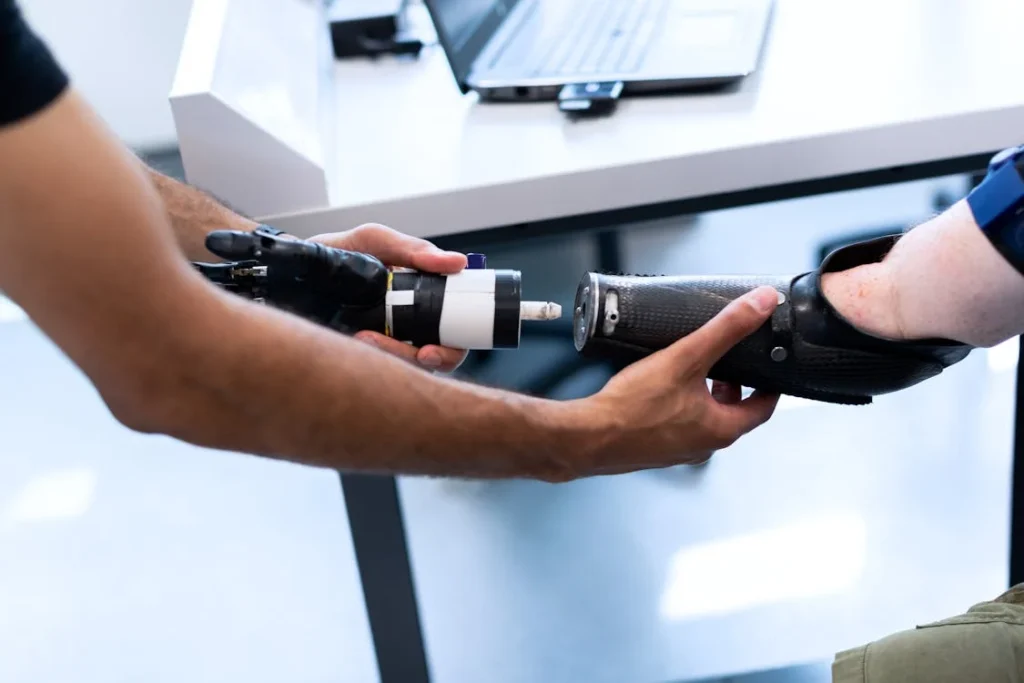
Understanding Traditional Prosthetics
Traditional prosthetics have been used for centuries to help people regain mobility and function after losing a limb. These prosthetics are designed to replace the missing body part and restore basic movement.
They do not have electronics or sensors but rely on simple mechanical structures to provide support.
One of the most common types of traditional prosthetics is a body-powered limb. This means the user controls the movement using cables and harnesses attached to their body.
For example, a person with a missing arm might use shoulder and upper body movements to open and close a prosthetic hand. While this requires some effort and practice, many people find it reliable.
There are also passive prosthetics, which do not move but are shaped to look like a real limb. These are often used for cosmetic reasons or in cases where function is not the main concern.
For leg prosthetics, traditional models include simple mechanical joints and sockets that fit over the residual limb, allowing the person to walk with a natural gait.
Benefits of Traditional Prosthetics
One of the biggest advantages of traditional prosthetics is affordability. Because they do not have advanced technology, they are usually more cost-effective than bionic limbs. This makes them a good option for people who need a prosthetic but may have financial limitations.
Durability is another major benefit. Traditional prosthetics are built to last, especially body-powered versions. They do not rely on batteries or electronic components, so there is less risk of failure due to technical issues.
This makes them a practical choice for people who live in areas with limited access to maintenance services.
Comfort is also a key factor. Since traditional prosthetics have been around for so long, they have been refined to provide a good fit.
Many people find that once they get used to their prosthetic, it becomes a natural part of their body. With proper fitting and adjustments, traditional limbs can be worn for long hours without causing discomfort.
Limitations of Traditional Prosthetics
Despite their advantages, traditional prosthetics do have some limitations. One of the biggest challenges is that they require physical effort to operate.
Body-powered prosthetics, for example, depend on the user’s muscle strength, which can lead to fatigue over time. This can be a problem for people who have limited strength or mobility.
Another drawback is the lack of advanced movement. Unlike bionic limbs, traditional prosthetics cannot mimic the natural motion of a human limb. This means that tasks requiring fine motor skills, such as picking up small objects or typing, can be difficult.
Aesthetic appearance can also be a concern. While some traditional prosthetics are designed to look like real limbs, they often lack the natural movement and responsiveness of bionic options.
This can make them feel less lifelike, which may be important for people who want a prosthetic that blends seamlessly with their body.
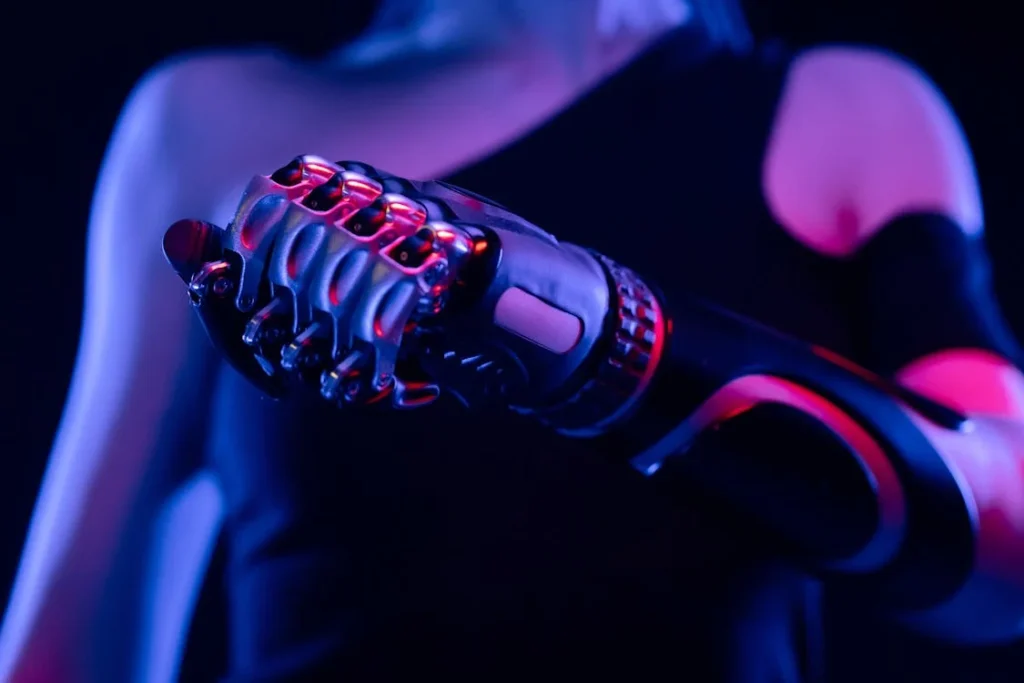
Understanding Bionic Prosthetics
Bionic prosthetics represent the future of artificial limbs, using advanced technology to restore movement and function in ways that traditional prosthetics cannot.
Unlike body-powered or passive limbs, bionic prosthetics are designed with sensors, microprocessors, and even artificial intelligence to create a more natural and intuitive experience for users.
These high-tech limbs respond to muscle signals, brain activity, or external controls, allowing for smoother, more precise movements.
One of the key features of bionic prosthetics is their ability to replicate human motion. A bionic hand, for example, can open and close fingers independently, providing a stronger grip and better control for everyday activities.
Some bionic hands, like Grippy™ by Robobionics, even include touch sensors that allow users to sense pressure, making it easier to handle delicate objects like a glass of water or a smartphone.
For leg prosthetics, bionic knees and ankles use microprocessors to adjust in real time, helping users walk with a more natural gait. These intelligent limbs can adapt to different terrains, such as stairs, slopes, or uneven ground, reducing strain on the rest of the body.
This makes movement smoother and more comfortable compared to traditional prosthetics, which require more manual adjustments.
Benefits of Bionic Prosthetics
One of the biggest advantages of bionic prosthetics is the ability to restore near-natural movement. Because these limbs use electronic sensors and smart technology, they can react quickly to the user’s commands.
This is especially helpful for people who need precision in their daily activities, such as typing on a keyboard, cooking, or playing a musical instrument.
Bionic prosthetics also improve comfort and reduce strain. Traditional prosthetics rely on mechanical force from the body, which can cause fatigue over time.
In contrast, bionic limbs operate with minimal physical effort, using motorized joints and intelligent algorithms to move naturally. This reduces stress on the body and allows users to wear the prosthetic for longer periods without discomfort.
Another major benefit is adaptability. Some bionic limbs come with mobile apps that let users customize movement settings according to their needs.
This means that someone can program their bionic hand to have different grip patterns for holding a coffee cup, writing with a pen, or shaking hands. Such features make bionic prosthetics highly versatile, giving users more control over their daily activities.
Limitations of Bionic Prosthetics
Despite their advanced features, bionic prosthetics are not without challenges. One of the biggest concerns is cost. Because these limbs use cutting-edge technology, they are more expensive than traditional prosthetics.
However, considering their long-term benefits, many users find them worth the investment. At Robobionics, we aim to make bionic prosthetics more affordable and accessible, offering innovative solutions like Grippy™, which combines high performance with cost-effectiveness.
Another challenge is maintenance. Since bionic prosthetics rely on electronic components, they require regular charging, software updates, and occasional repairs.
While they are designed to be durable, damage to sensors or motors can lead to downtime. However, Robobionics provides local support and servicing, ensuring that users have access to quick and efficient maintenance.
Learning to use a bionic limb can also take time. While traditional prosthetics rely on physical movement, bionic limbs often require users to learn how to control them with muscle signals or external inputs.
This means some people may need rehabilitation and practice to get comfortable with their new prosthetic. Fortunately, Robobionics offers gamified home-based rehabilitation, making the learning process engaging and effective.
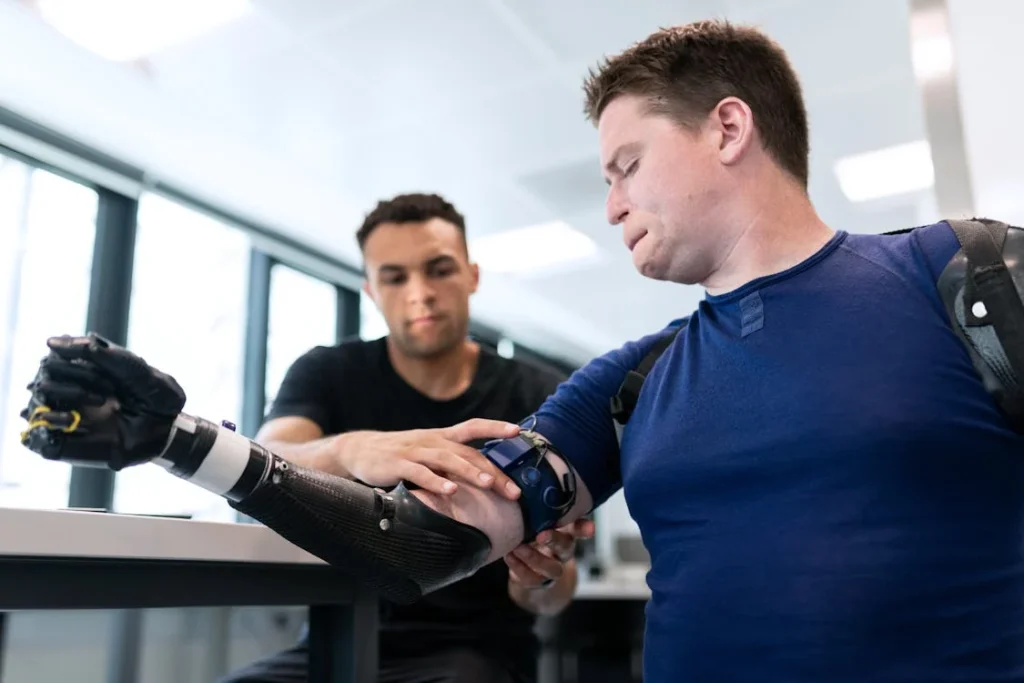
Choosing the Right Prosthetic: Factors to Consider
Deciding between a traditional prosthetic and a bionic one is not always easy. Every person’s needs are unique, and what works for one individual may not be the best choice for another.
Several factors play a role in determining which type of prosthetic is the right fit. These include lifestyle, budget, personal goals, and comfort. Understanding how each of these factors influences your decision can make the process smoother and more informed.
Lifestyle and Daily Activities
One of the most important things to consider when choosing a prosthetic is how you plan to use it in your everyday life. If your daily activities involve simple movements like walking, standing, or holding lightweight objects, a traditional prosthetic might be enough.
Many people find body-powered or mechanical limbs effective for these tasks, especially if they do not require precise finger movements or complex coordination.
However, if you have an active lifestyle or need advanced functionality, a bionic prosthetic may be a better choice. Bionic limbs offer a greater range of motion and allow for more natural movements.
A person who enjoys activities like sports, cycling, or even playing an instrument might benefit from the enhanced control that bionic prosthetics provide.
Advanced robotic hands can grip objects with different levels of pressure, allowing users to handle delicate items like a phone or a glass of water without worrying about dropping them.
Similarly, bionic legs with microprocessor-controlled joints make walking smoother and more efficient, especially for those who need to navigate different terrains.
Comfort and Fit
Another crucial factor to consider is how comfortable the prosthetic feels. A well-fitting limb should not cause pain or discomfort, even after long hours of use.
Traditional prosthetics, when properly fitted, can be comfortable, but they often require adjustments over time as the body changes.
Some people find that traditional prosthetics put extra strain on the body, especially if they are body-powered, since they rely on the user’s muscle strength to function.
Bionic prosthetics, on the other hand, are designed to work with the body’s natural movements. They use sensors and motors to assist in movement, reducing the physical effort required.
This makes them a good option for people who experience fatigue or muscle strain when using a traditional prosthetic. The added comfort of bionic limbs allows users to wear them for longer periods without experiencing soreness or pressure points.
Cost and Long-Term Investment
Budget is a significant factor when selecting a prosthetic. Traditional prosthetics are generally more affordable upfront because they do not include electronics or advanced technology.
This makes them a suitable option for people looking for a basic solution that provides function without additional features. However, while the initial cost is lower, traditional prosthetics may require replacements or adjustments over time, adding to long-term expenses.
Bionic prosthetics, while more expensive initially, offer long-term benefits that may outweigh the cost. Their advanced technology provides greater functionality, making daily tasks easier and more efficient.
Many users find that investing in a bionic limb improves their overall quality of life by reducing physical strain and increasing independence.
Additionally, Robobionics offers cost-effective bionic solutions like Grippy™, ensuring that more people can access high-quality prosthetic technology without breaking the bank.
Rehabilitation and Adaptation
Adapting to a new prosthetic takes time, whether it is traditional or bionic. Learning how to use a prosthetic limb effectively requires patience and practice.
Traditional prosthetics often require users to build muscle strength and coordination, which can take some effort in the beginning. Since body-powered limbs rely on harnesses and cables, they may feel unnatural at first and require training to use smoothly.
Bionic prosthetics come with their own learning curve, especially if they involve myoelectric controls, which use muscle signals to operate.
Some users may need rehabilitation to get accustomed to controlling the limb through muscle movements or external inputs. To make this process easier,
Robobionics provides gamified home-based rehabilitation programs, helping users build confidence and skill in a fun and engaging way.
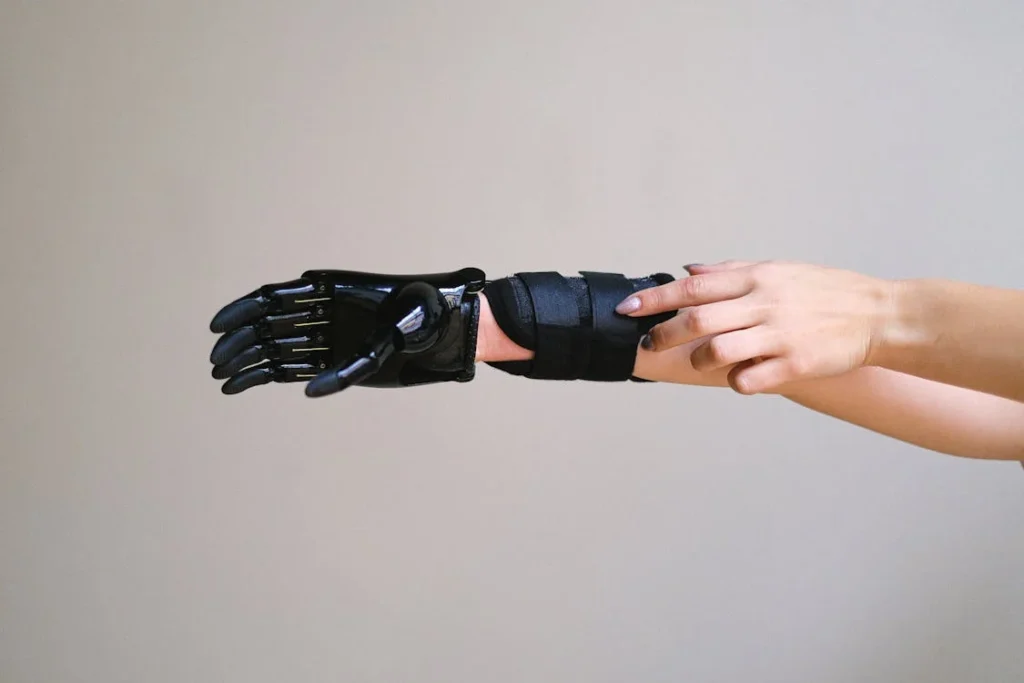
Making the Final Decision: Which One Is Right for You?
Choosing between a traditional prosthetic and a bionic one ultimately depends on your unique circumstances. While both types of prosthetics aim to restore function and improve quality of life, the right choice varies based on personal needs, lifestyle, and long-term goals.
Understanding Your Needs
The first step in making a decision is evaluating your daily routine and how you plan to use your prosthetic. If you need a basic solution for simple tasks like walking, standing, or gripping larger objects, a traditional prosthetic may be enough.
Many users who do not require fine motor control or advanced movement find traditional limbs practical and effective.
However, if you need greater dexterity, a bionic prosthetic is the better choice.
If your job, hobbies, or lifestyle involve activities that require precise hand movements—such as typing, cooking, or handling delicate objects—then a bionic limb can provide more natural and effortless control.
Similarly, for those using a prosthetic leg, a bionic knee or ankle can help navigate stairs, slopes, and uneven surfaces more smoothly than a traditional mechanical limb.
Another important factor to consider is whether you need sensory feedback. Many bionic prosthetics, such as Grippy™ by Robobionics, offer touch sensors that allow users to feel the pressure of objects they are holding.
This can make everyday tasks easier and improve overall control. Traditional prosthetics, while functional, do not provide this level of interaction.
Long-Term Value and Maintenance
Durability and maintenance are crucial when selecting a prosthetic. Traditional prosthetics are known for their longevity and do not require charging or software updates, making them a reliable option for those who prefer a low-maintenance solution.
They are often preferred by individuals who work in environments where exposure to dust, water, or extreme conditions could damage electronic components.
On the other hand, bionic prosthetics require some upkeep. Since they rely on electronic parts, users must ensure that the battery is charged, software is updated, and sensors remain in good working condition.
While this might seem like an added responsibility, the benefits of a bionic limb’s functionality often outweigh the minor inconvenience of regular maintenance.
Robobionics provides excellent after-sales support, making servicing and repairs easy and accessible for users who choose bionic options.
Emotional and Psychological Factors
Adjusting to life with a prosthetic is not just a physical journey—it is an emotional one as well. Some users feel more confident and comfortable with a prosthetic that closely mimics the look and feel of a real limb.
Bionic prosthetics often provide a more lifelike experience, both in movement and appearance, which can boost self-esteem and confidence.
For some, simplicity is key, and a traditional prosthetic provides all the function they need without unnecessary complexity.
Others may find that the advanced features of a bionic prosthetic help them feel more independent and capable, enhancing their overall well-being.
Personal preference plays a big role, and it is important to choose a prosthetic that makes you feel comfortable, both physically and mentally.
The Future of Prosthetics: Where Technology is Headed
Prosthetic technology continues to advance, and bionic limbs are becoming more sophisticated and accessible.
As research progresses, the gap between traditional and bionic prosthetics is narrowing. More affordable bionic options are emerging, giving users access to advanced features without the high cost.
At Robobionics, we are committed to making high-quality bionic prosthetics available to more people. With products like Grippy™, we provide an affordable yet powerful alternative to expensive imported prosthetics.
Our goal is to empower users with advanced technology while ensuring durability, comfort, and ease of use.
If you are considering a prosthetic and are unsure which option is best for you, we encourage you to explore both traditional and bionic solutions.
Book a free demo of Grippy™ today and experience the difference for yourself. Our experts are here to help you find the perfect fit for your needs, ensuring that you regain mobility, confidence, and independence.
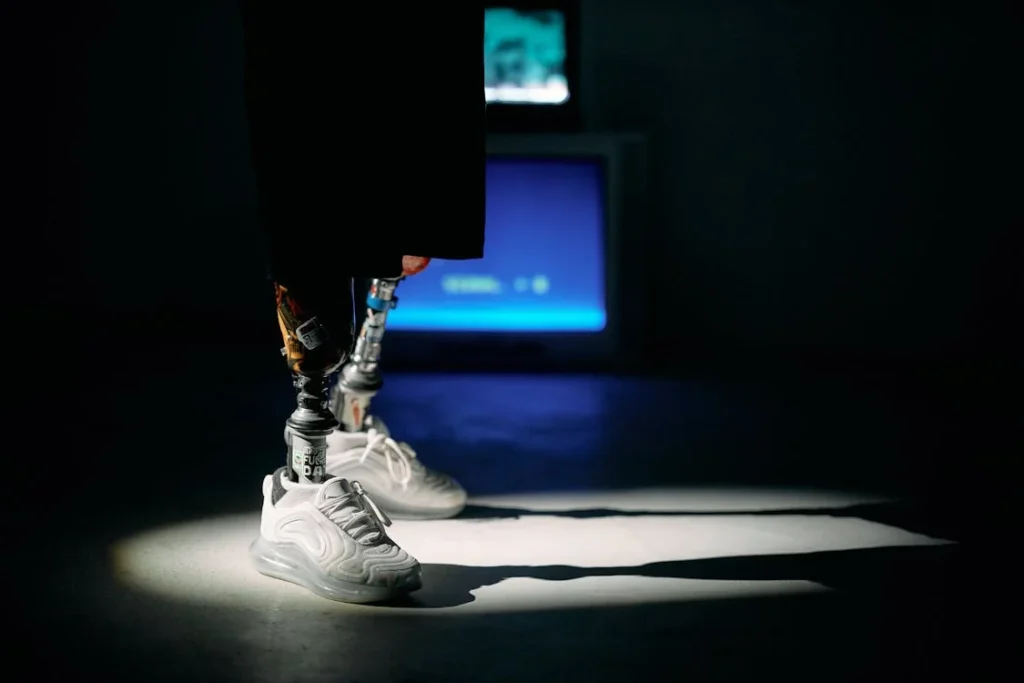
The Role of Rehabilitation in Maximizing Prosthetic Use
No matter which type of prosthetic you choose, one of the most important aspects of the journey is rehabilitation. Adjusting to a prosthetic limb is not just about putting it on and using it—it involves training your body and mind to work with the new device.
Proper rehabilitation ensures that you get the most out of your prosthetic, whether it is traditional or bionic.
Learning to Use a Prosthetic Effectively
When a person first starts using a prosthetic, there is often a period of adjustment. For those using a traditional prosthetic, this may involve strengthening the muscles needed to control body-powered movements.
It can take time to get used to the harness and cables that operate a mechanical limb. People using passive prosthetics may need to work on balance and posture to move comfortably.
For bionic prosthetic users, the learning process is different but just as essential. Since bionic limbs rely on muscle signals or other electronic controls, users often need to train their brain and muscles to send the right signals.
This is especially true for myoelectric prosthetics, which detect electrical impulses from muscles to control movement. At first, this can feel unfamiliar, but with regular use and guidance, it becomes second nature.
To help users adapt faster, Robobionics offers a gamified rehabilitation approach. This makes learning engaging and enjoyable by turning practice sessions into interactive experiences.
Instead of repetitive exercises, users can engage with fun, game-like activities that help them master control of their prosthetic while keeping them motivated.
Strengthening Muscles and Coordination
Rehabilitation is not just about learning how to use a prosthetic—it also involves strengthening the muscles that support movement.
When someone loses a limb, the surrounding muscles may weaken due to lack of use. Physical therapy helps rebuild strength and improves overall coordination.
For prosthetic leg users, exercises focus on improving balance, posture, and walking mechanics. This is particularly important for bionic prosthetics with microprocessor-controlled joints, as users must learn to trust the limb’s responsiveness.
Over time, the body adjusts to the prosthetic’s motion, allowing for a more natural gait.
For prosthetic hand users, therapy often includes grip training, finger coordination, and fine motor skill development. Whether using a traditional or bionic hand, practicing everyday tasks like writing, picking up objects, and gripping different materials helps improve dexterity.
With bionic prosthetics like Grippy™, which include multi-grip functions, users can practice switching between different grip patterns for various activities.
The Psychological Side of Rehabilitation
Adapting to a prosthetic is not just a physical challenge—it is also a mental and emotional journey. Many individuals experience frustration in the early stages of prosthetic use, especially when tasks that once seemed simple become difficult.
Rehabilitation helps build confidence and teaches users how to overcome these challenges with patience and practice.
Support from family, friends, and medical professionals plays a crucial role in this process. Having a strong support system encourages users to stay motivated and push through the learning curve.
Robobionics understands this and ensures that users have access to expert guidance, whether through in-person support or digital resources.
The Long-Term Benefits of Rehabilitation
A well-structured rehabilitation program leads to long-term success with a prosthetic limb. Proper training helps users become independent, improving their ability to perform daily tasks and reducing reliance on assistance.
It also prevents injuries caused by improper use, such as muscle strain or joint stress.
At Robobionics, we believe that rehabilitation is just as important as the prosthetic itself. That is why we integrate home-based rehabilitation programs into our services, ensuring that users can practice and improve at their own pace.
Whether you choose a traditional prosthetic or a bionic one, rehabilitation is the key to unlocking your full potential.
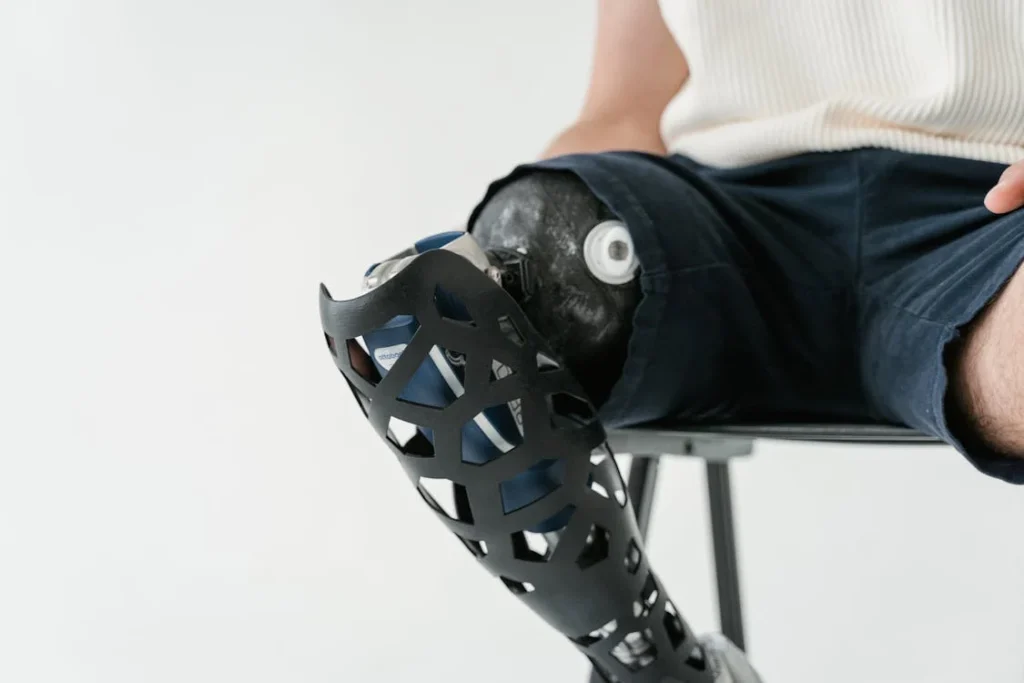
The Impact of Prosthetics on Quality of Life
Choosing the right prosthetic is not just about movement—it’s about reclaiming independence, confidence, and a sense of normalcy. Whether traditional or bionic, a prosthetic limb has the power to transform everyday life in ways that go beyond just physical function.
The right prosthetic can open doors to new opportunities, allowing individuals to pursue careers, hobbies, and social activities with ease.
Restoring Independence in Daily Life
One of the biggest benefits of prosthetics is the ability to perform daily tasks without assistance. For individuals who have lost a limb, simple activities like dressing, eating, or writing can become challenging.
A well-fitted prosthetic helps users regain control over these tasks, making them feel more independent.
Traditional prosthetics, while effective for basic movements, sometimes require more effort and practice to master. Many users find that they need to adjust their posture or rely on compensatory movements to perform certain tasks.
However, for those who prefer a straightforward, reliable solution, a traditional prosthetic can provide the function needed to carry out essential activities.
Bionic prosthetics take independence a step further by offering intuitive control and advanced movement. A bionic hand, for example, can allow users to grip objects with different levels of force, making it easier to handle delicate or heavy items.
Bionic legs with microprocessor-controlled joints can adjust in real-time, helping users walk more naturally without having to think about every step. This technology makes everyday activities feel more seamless and effortless.
Boosting Confidence and Emotional Well-Being
Losing a limb can have a significant emotional impact, affecting self-esteem and social confidence. Many individuals feel self-conscious about their appearance, especially when adjusting to life with a prosthetic.
Choosing the right prosthetic can play a crucial role in restoring confidence and making users feel more comfortable in their own skin.
For some, a natural-looking passive prosthetic provides reassurance by closely resembling a real limb. Others find that a highly functional bionic limb empowers them to focus on what they can do, rather than what they have lost.
The ability to perform daily activities independently often leads to an improved sense of self-worth and optimism about the future.
Social interactions also become easier when a prosthetic functions smoothly. Bionic hands with responsive grip control make handshakes, gestures, and other forms of nonverbal communication feel more natural.
A bionic leg that adapts to different walking speeds and terrains allows users to move confidently in social settings without worrying about balance or fatigue.
Expanding Career and Hobby Opportunities
Prosthetics not only restore function but also enable users to explore career paths and hobbies that might have seemed difficult after limb loss. A well-designed prosthetic can make it possible to return to work, participate in sports, or engage in creative activities with ease.
Traditional prosthetics are often suitable for jobs that require standing, walking, or performing routine manual tasks. People in fields like retail, teaching, or office work may find that a mechanical limb meets their needs effectively.
However, for professions that demand precision, such as surgery, engineering, or musical performance, a bionic prosthetic can offer better control and flexibility.
Sports enthusiasts also benefit greatly from the right prosthetic. While traditional prosthetic legs allow for basic mobility, specialized bionic limbs are designed for running, cycling, and other athletic activities.
With advanced shock absorption and adaptive movement, bionic prosthetics provide users with the stability and performance needed for high-impact movements.
The Role of Technology in Shaping the Future
As prosthetic technology continues to evolve, the line between traditional and bionic limbs is becoming less distinct. Innovations in materials, artificial intelligence, and neural interfaces are making prosthetics more advanced than ever before.
Researchers are even developing mind-controlled prosthetics that respond to brain signals, creating a seamless connection between the body and the artificial limb.
Robobionics is at the forefront of this progress, designing prosthetics that combine affordability with cutting-edge technology. With solutions like Grippy™, we make bionic prosthetics more accessible, ensuring that users do not have to compromise on quality or function.
Ultimately, the impact of prosthetics extends far beyond mobility. They shape the way individuals experience the world, interact with others, and pursue their passions.
Whether you choose a traditional or bionic prosthetic, the goal remains the same—to live a fulfilling, independent life without limitations.
Conclusion
Choosing between a traditional and a bionic prosthetic is a deeply personal decision that depends on lifestyle, comfort, budget, and long-term goals. Traditional prosthetics offer reliability, affordability, and durability, making them a solid choice for basic mobility and function. Bionic prosthetics, on the other hand, provide advanced movement, greater independence, and a more natural experience, making them ideal for those who seek precision and adaptability in daily life.
Regardless of the choice, the journey does not end with selecting a prosthetic. Rehabilitation, training, and emotional adjustment play a crucial role in maximizing its benefits. At Robobionics, we are committed to making prosthetic technology accessible, ensuring that users not only receive a high-quality limb but also the support needed to integrate it seamlessly into their lives.
If you are still unsure about which prosthetic is right for you, we invite you to book a free demo of Grippy™ and experience firsthand how bionic technology can enhance daily life. Our team is here to guide you through the process, helping you regain confidence, mobility, and independence. Contact us today and take the first step toward a future without limits!



